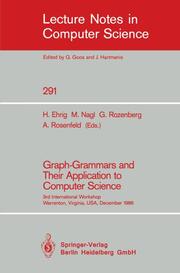Detailansicht
Graph-Grammars and Their Application to Computer Science
3rd International Workshop, Warrenton, Virginia, USA, December 2-6,1986, Lecture Notes in Computer Science 291
ISBN/EAN: 9783540187714
Umbreit-Nr.: 1460316
Sprache:
Englisch
Umfang: x, 622 S.
Format in cm:
Einband:
kartoniertes Buch
Erschienen am 17.12.1987
- Zusatztext
- InhaltsangabeTutorial introduction to the algebraic approach of graph grammars.- May we introduce to you: Hyperedge replacement.- An introduction to parallel map generating systems.- Set theoretic approaches to graph grammars.- An introduction to the NLC way of rewriting graphs.- Array grammars.- Graph grammar based specification of interconnection structures for massively parallel computation.- Towards distributed graph grammars.- On partially ordered graph grammars.- A representation of graphs by algebraic expressions and its use for graph rewriting systems.- On context-free sets of graphs and their monadic second-order theory.- Restricting the complexity of regular DNLC languages.- Apex graph grammars.- Graph grammar engineering: A software specification method.- A linguistic formalism for engineering solid modeling.- Graph grammars and diagram editing.- Graphics and their grammars.- On network algebras and recursive equations.- Ada-concurrency specified by graph grammars.- Basic notions of actor grammars.- Embedding rule independent theory of graph grammars.- Supporting the software development process with attributed NLC graph grammars.- Practical applications of precedence graph grammars.- Is parallelism already concurrency? Part 1: Derivations in graph grammars.- Is parallelism already concurrency? Part 2: Non-sequential processes in graph grammars.- Map OL-systems with edge label control: Comparison of marker and cyclic systems.- From 0L and 1L map systems to indeterminate and determinate growth in plant morphogenesis.- Fundamentals of edge-label controlled graph grammars.- Parallelism analysis in rule-based systems using graph grammars.- An efficient algorithm for the solution of hierarchical networks of constraints.- A software development environment based on graph technology.- Map 0L systems with markers.- Graph rewriting with unification and composition.- Complexity of pattern generation via planar parallel binary fission/fusion grammars.- Applications of L-systems to computer imagery.- Advances in array languages.- Rosenfeld's cycle grammars and kolam.- Application of graph grammars in music composing systems.- Boundary NLC and partition controlled graph grammars.
